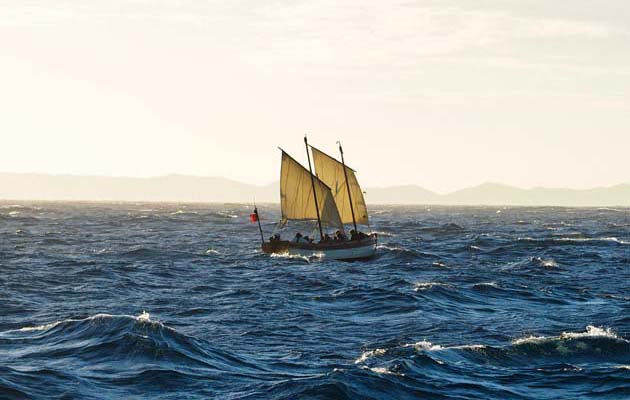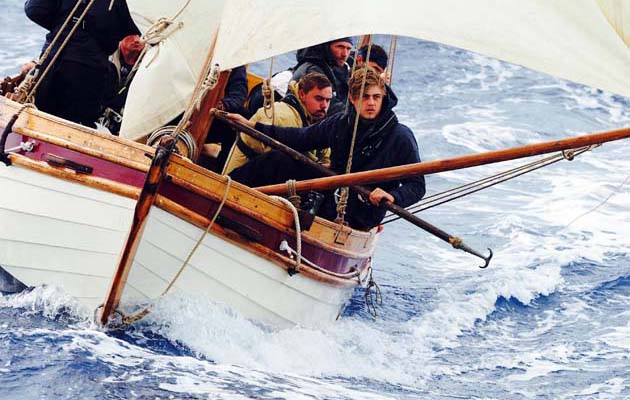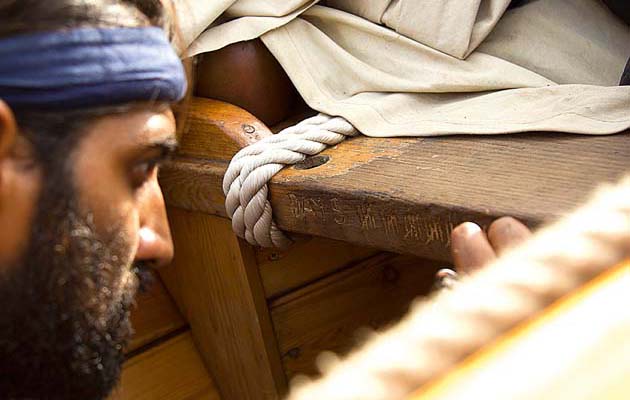Conrad Humphreys on the real sailing perils encountered during the TV recreation of the voyage of William Bligh and 18 men cast adrift after the Mutiny on the Bounty in 1789.
We staggered up the beach in a remote part of Timor, our weary legs gave way as each of us collapsed onto the pebbly shoreline. Tears of relief ran down our cheeks as we sat motionless for the first time in over 60 days taking in our strange surroundings. I felt oddly numb.
Looking back out to sea at the tiny 23ft wooden boat that had been our world since leaving Tonga, I suddenly wanted to be back on board. Cameras, interviews, people, hassle – surely Bligh didn’t have to contend with this. Maybe he did?
He certainly did not arrive to a hero’s welcome. His men were half dead and most would die within a few weeks of their arrival.
This was to be our story, a modern day recreation of Bligh’s 4,000-mile open boat voyage from Tofua where he was cast adrift from HMS Bounty to Timor where he skilfully navigated Bounty’s launch through some of the world’s most remote islands and treacherous reefs.
Bligh’s only mantra was survival. Cast adrift after a mutiny, he and his followers were left for dead with enough rations for only a few days’ sailing, a sextant, some declination tables, a pocket watch and some carpenter’s tools.
No-one really knows what was in his mind as he pointed the launch towards Tofua, 35 miles away, but what unfolded was the greatest feat of navigation and survival in British history, although Bligh was not regarded as a hero by any of his peers.
When I was first approached by Windfall Films to be the professional skipper on board this ambitious recreation, my heart raced at the thought. I’ve never been shy of taking on sailing challenges, but this was at best audacious – at worst reckless.
A crew made up of mainly non-sailors: a handyman in place of a ship’s carpenter; a student doctor in for a surgeon; and a whisky salesman in place of the ship’s clerk. To think that we could really pull this off was bold to say the least.
Could modern man survive the same fate as Bligh and his men? Clearly we could and did.



Many comparisons will be drawn about Bligh and his ability to lead his men to safety. For us, our captain was former SBS soldier Ant Middleton.
Like Bligh he was only 35, but unlike Bligh he was not an experienced sailor. Ant does know how to survive and shouldered the weight of leadership like he was born to be on water.
When I looked across to him one night as the wind howled and the heavens unleashed a torrent of rain on our shivering, terrified crew, he looked at me with a broad grin. It was enough for me to realise that, like 1789, it’s only wind and water and if we kept sailing west we’d eventually arrive.
From the moment we were cast adrift 35 miles south-west of Tofua, I knew that I would no longer have access to any weather information. As a sailor, not being able to forecast would mean navigating with a far wider margin for error.
When Bligh was cast adrift, he was given some of his navigation equipment, including a sextant and a pocket watch. He would not have had any idea of the expected forecast.
In the months before we were cast adrift, I studied the weather every day and tried to build up a knowledge of the patterns in my head. Bligh had charted many of the islands around Tonga and Fiji with Captain Cook, and was able to recall them in his head. I hoped that I would be able to do the same.
As the rope was cut and we were cast adrift, I knew that within five days the weather was due for a turn. The tradewinds, south-easterlies, that would blow us along at up to five knots would be replaced by a strong south-westerly front and what looked to be a serious amount of rain.
Like Bligh, we would set sail to Tofua to get extra supplies and water. I was nervous about wasting time on Tofua, but agreed that one night would be OK as long as we set sail early the next day.

Conrad Humphreys


Ant Middleton

My objective was to get safely through the Lau Group of islands and reefs that lay some 200 miles to our north-west before the winds changed. We arrived at Tofua on the evening of the first day, just before dark, so we decided to hold off until first light.
That evening the winds picked up and gave us all a taste of what was to come. The waves broke over the boat and by daybreak we were all soaked to the bone.
Making landfall the following day took a huge effort, with the strong Trades blowing us away from the island. Bounty’s End was cursed with an inability to go to windward, so a long and arduous row was necessary. All the time, the clock was ticking…
The stop on Tofua proved fruitless, with only a handful of coconuts to show for our efforts. Meanwhile we were now a day behind my schedule and our strategy to follow Bligh’s original course through the Lau Group and ‘Bligh’s Passage’, was now looking extremely dodgy.
Worse, the Trades were weaker than the previous day, so our progress towards the Lau Group was not as I had expected.
As time wore on, I calculated that we would not pass through the Lau Group in time and decided we should get some more southing into our westerly course. Ideally we’d aim to pass to the south of the islands before the wind veered into the south-west, allowing us enough sea room to the north if we need to run off on our approaches to Fiji.
That was the plan. The sunset looked a little ominous as we spotted our first island out to the west.
We were not quite as far south as I’d have liked, but there was a reasonable four-mile gap between the reefs that I thought we’d be able to sail through.
I briefed Ant and the crew on what to expect. We would attempt to sail west through the reefs and to the south of a small island called Kabara.
From there, we’d be able to bear away a few degrees and head for the next volcanic island. This approach to navigation is not something that I’ve ever done before, heading towards an island to pinpoint your position.
The early Polynesians were masters at wayfinding, which was done exactly like this and I’m sure that Bligh used the same techniques. That night as we passed between the reefs, I asked the guys to listen out for any sound of breaking water.



We were all tense and then all hell broke loose. Suddenly the wind changed direction and picked up dramatically.
It was a weather front and we were now on a course heading towards Kabara Island. I called for a reef to be put in both sails which, given the experience on board, proved to be a nightmare.
In the confusion, bodies were caught up in the sails and yards, at one point the sails ended up in the water, and all the time, I was concerned that we were being blown north onto the reefs.
We eventually got the sails set and with everyone packed into the windward side of the boat as ballast we attempted to sail as close-hauled as possible.
The waves were now beam on and at best I estimated that we were making a course of due west over the ground. Kabara was only a few hundred metres wide, so we needed to hold our nerve and get to windward of the island before easing sheets and bearing away a few degrees.
I could hear the waves booming on the reef to leeward and now every wave that broke over the boat made me imagine the worst.
I tried to put in a call to our support boat, to ask them to warn us if we got to close to the reef. Unbeknownst to us, the support boat had in fact lost visual contact with us in the weather front and were unable to see our radar trace on their screen. The radio was silent.
Thoughts were now racing through my head: do I bear away hard and try and pass to the north of the island or hold my nerve? What the hell were we doing in this situation, with a crew almost paralysed with fear and a support boat unable to render any assistance?
We had to hold our course. I looked over at Ant, who looked back at me with a broad grin. It was the comfort I needed. It’s only wind and water and if we kept heading west, we’d get through it.
Endless rain
You would never have thought that too much rain would become a major issue during the recreation of Mutiny. Bligh also experienced a lot of rain during his voyage, which caused great suffering to his men.
In the first two weeks of our voyage it rained constantly, in fact during one 96-hour period it rained without stopping. Rain was the devil on board.
It sucked morale and, as Ant Middleton expressed, tapping his head one day: “It just gets into your head… tick, tick tick.”
Without shelter, we would strip as quickly as possible and put on our wet clothes to try and save what dry clothes we had. Not everyone could be bothered with this life-preserving routine and before long some of the crew experienced severe shivering and found it difficult to keep warm. We took it in turns to do squats and exercises to try and keep warm.
We had capacity to store 140 litres of water (seven days’ worth at our recommended 2lt/day) in two large 50lt barrels and four smaller 10lt barrels. We refilled the barrels on land, where we found natural water sources.
In Yandua we found a freshwater seep coming out of the ground. In Vanuatu, there had been a drought and the locals drank from a small stagnant pool. We ran a rolling boil to purify the water, but it still tasted foul.
During the 1,600-mile leg to Restoration Island one 50lt barrel smelt sulphurous. We had no choice but to continue to drink from it, but everyone suffered from the effects with stomach cramps and diarrhoea.
After we crossed through the Great Barrier Reef and made landfall on Restoration Island we were able refill the barrels, however the bacteria in the bad barrel was not properly removed and on the final stretch of the voyage it would come back to haunt us.
Bligh stopped a few times along Cape York peninsula. We made landfall on Sunday Island, but found no water and again on Albany, the most northerly island off Cape York.
Here all we found was an old boat with hundreds of litres of rainwater in the bilge. We again topped up, but when we left Albany, it was clear that we would need to conserve our water. We’d be right on the limit with just a litre of water per person per day.
Progress was good along the northern tip of Australia and we hit some of our best daily runs of the whole trip passing through the Torres Strait and across the Gulf of Carpentaria. The mood on board was good and confidence in our water situation was high.
We passed through a couple of smaller rain squalls, but such was the fear of rain from the crew, no effort was made to collect it. In fact it caused quite a lot of angst that we again would be subject to more rain.
I briefed everyone that, from the earlier climatology study, the weather in the Arafura and Timor Seas would get progressively lighter as the tradewinds reduced the further west we travelled. We should expect to slow up.
My briefing fell on deaf ears. Rain was still seen as the devil!

Progress slows as the wind dies
Water in one of the 50lt barrels started to smell very sulphurous and quickly became undrinkable. It meant that we only had around 40lt of water with still over 800 miles to Timor.
Progress slowed dramatically as we encountered a ridge of high pressure and our daily average dropped from 100-plus miles down to 50. It was obvious that we were going to struggle on the water we had, so Ant took control of the ladles and we reduced our consumption down to 600ml per day.
After 48 hours in the sweltering heat, which was melting the camera batteries, I felt that we needed to change our tactics. The high pressure system had intensified over us and I believed from the wind direction and the cloud formations that we were right in the centre of the system with no obvious quick way out.
I wanted to do two things, the first was to lighten the boat and transfer anything that was non-essential over to the support boat. The second was that for those of us that were fit enough (and not all were) we would do a bit of rowing in the night.
There were small patches, zephyrs of wind that we needed to get to and with just one person on the oars, enough momentum was created to generate some apparent wind to keep us moving.
Ant did not agree with my plan. He felt we were all too weak to row and preferred to sit tight, conserve energy and wait for the wind to fill.
I understood the need to conserve energy, but I felt strongly that doing nothing was not an option and the only way out of the high pressure was to move towards Timor, however slowly.
Ant called a crew meeting and the vote was to wait for the wind and give it a further 48 hours. I was pretty angry and for the first time in the voyage I disagreed with Ant. We would run out of water before the wind returned.
After waiting a further 48 hours, we went to my plan and started to lighten the boat, everything non-essential went overboard (to be collected by the support boat). We were down to the last drops of water and it was clear that we would need an intervention or risk dehydration and possible long-term health problems. Everyone was in a terrible state.
Our support crew knew we were in trouble and radioed us to say that we needed to drink urgently and that they would resupply us with 20lt of water during the next barrel drop. I’ve no doubt that had we not had that intervention, we would have experienced severe dehydration and ultimately death in the Timor Sea.
Having drunk enough water to rehydrate, we set out to row and soon found ourselves in a strong westward flowing current that was taking us towards the Timor coast. I noted the strength of the current as we passed an oceanic buoy and estimated it to be at least two knots.
We spotted land to the north-west and our hopes and dreams of completing the voyage soon filled the boat. The burst of adrenaline and energy that Ant predicted when we saw land spurred us on and soon we spotted wind and signs of civilisation in the form of fishing boats on the horizon.

In the final hours before making landfall, we were treated to one of the most spectacular sunsets of the entire voyage.
We were now in Timor, and on the beach was a shack selling chocolate and Coca-Cola. Seven tired and hungry soulmates stepped ashore and wept with joy.




